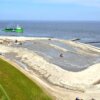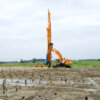Prefabricated vertical drains (PVDs) or Wick drains are applied in areas where loose, compressible, water-saturated soils make the soil unstable.
Soil stablisation
Soil stabilisation using prefabricated vertical drains (PVDs) or Wick drains are applied in areas with loose, compressible and water-saturated soils such as clay and silty clays. These soils are characterised by a very weak soil skeleton and a large pore space, usually filled with water (pore water).
When a load such as a road embankment, a hydraulic fill or a dike, is placed on soft compressible soils, significant settlements may occur. These settlements can create serious problems. Any increase in load can also result in an increase of pore water pressure.
Soils with low permeability
In soils with low permeability, this water dissipates very slowly, gradually flowing from the stressed zone. Increased pore pressure may also cause soil instability and slip plane failures may result. A vertical drainage system – drains are generally placed in a square or triangular pattern, spaced at about 1 to 3 metres apart – allows for faster removal of excess pore water, thus decreasing the risk of slip plane failure.
Without vertical drains, soil consolidation and settlement can take a very long time, time that a project does not usually have. The consolidation of soft cohesive soils using vertical drains can reduce this settlement time from years to months ensuring that bearing capacity is adequate and infrastructure or other construction can commence rapidly.


















